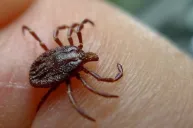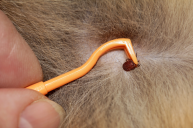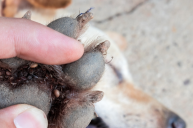Warm weather brings with it tick season! Is your dog prepared?
As the weather warms, the dogs go roaming and the ticks come crawling. Tick bites can result in tick-borne diseases, such as Lyme disease, Ehrlichia, Anaplasma, Babesiosis, and Rocky Mountain Spotted Fever. These diseases can lead to catastrophic health issues in your pet.
But there are ways to prevent canine tick infestations, including simply being on the lookout. While it can be difficult to spot adult ticks out on a hike until they attach to the body, tick nests and tick eggs are more noticeable—and there will be thousands of them.
What Do Tick Eggs Look Like?
https://www.instagram.com/p/BGuL558CLdR/
Tick eggs typically have a reddish-black, sometimes translucent appearance. Really, they look an awful lot like misplaced caviar, especially in shape and texture.
Black-legged adult female ticks lay eggs on the ground, often nestled in the grass, on- or off-trail. If they get stuck to clothes, fur, or body parts, they can be transferred back into or around the home where the environment is usually still conducive to hatching, leading to an infestation.
How Ticks Transmit Disease
https://www.instagram.com/p/B-AdGkNpehY/
A female tick very rarely passes on infectious diseases to her offspring. Instead, it is when the ticks begin consuming blood meals as larvae, nymph, and adult that they contract bacterial illnesses.
The nymph stage, just before adulthood in the tick lifecycle, is the most likely to transmit disease, in part because their small size makes them less noticeable than the mature ones. Also, nymphs ticks have already begun feeding on mice and other small rodents that could carry the different types of bacteria, including tularemia (rabbit fever).
How to Deal With Tick Bites
https://www.instagram.com/p/B9-o5oJFRqG/
If a tick does attach to your dog, don't panic. Remove the tick and then monitor for signs of a tick-borne illness. A simple blood test at the vet can also check for such diseases. In most cases, the tick has to have been attached for 24-48 hours in order to transmit disease.
Not every tick is infected either—in fact, most aren't. But it's always good to be prepared, particularly with dogs who, due to their wayfaring tendencies, are more likely to pick up multiple ticks on a hike than humans. That being said, tick populations and documented cases of tick-borne diseases are on the rise.
If you find tick eggs on you or your dog when you get home, drop the eggs in boric acid to prevent hatching. Rubbing salt on your dog's fur can also dry out any eggs that might remain. Ticks that have hatched can be removed with duct tape if they have not already attached.
Be sure to wash thoroughly both you and your dog if either of you finds any tick, in any life stage, on you.
A Quick Summary
https://www.instagram.com/p/B-ASRz2DKTj/
Let's unpack this a little! Ticks are a serious matter so if you live in or near a wooded area (year-round or on vacation) you should use tick prevention or tick control repellents. In addition to Lyme disease and Rocky Mountain spotted fever, tick exposure may transmit diseases including anaplasmosis, babesiosis, ehrlichiosis, and mycoplasmosis as we mentioned earlier.
There are many species of ticks depending where you live including the American dog tick or wood tick which is found in the eastern two-thirds of the United States. Other tick species include the brown dog tick, lone star tick, and deer tick.
How do you keep your dog free of ticks? Share at our Wide Open Pets Facebook!
This article was originally published March 21, 2020.




